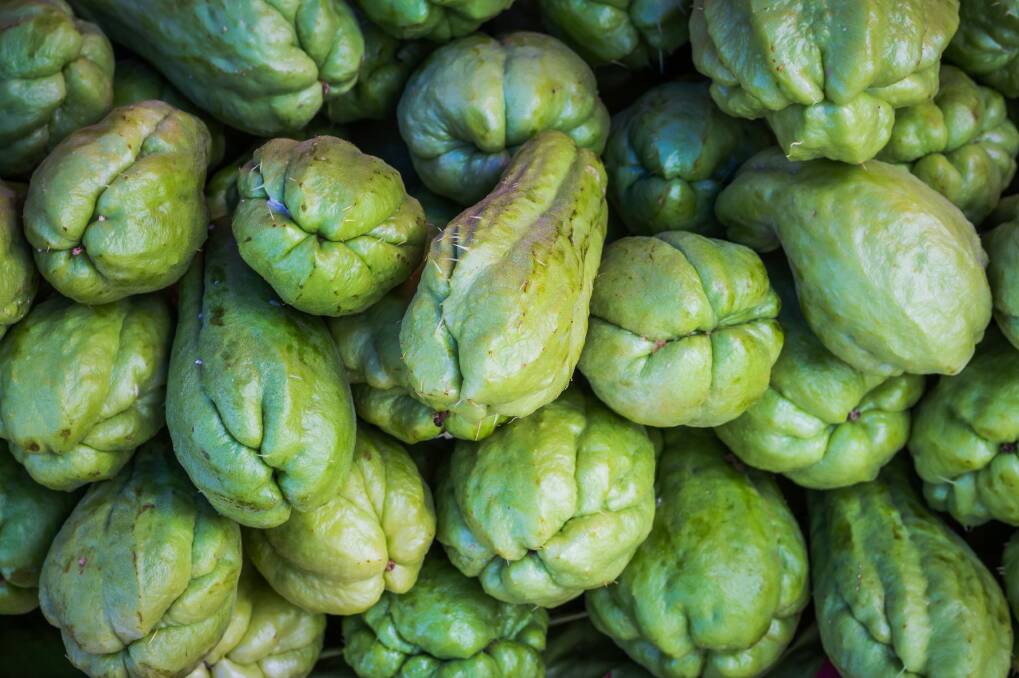Plants need to know their place. The natural (Aussie) setting for a choko vine should be covering a backyard dunny in leaves and fruit, or now that dunnies are an endangered species, neatly climbing up a trellis.
Subscribe now for unlimited access.
$0/
(min cost $0)
or signup to continue reading
Our choko vine has no decorum. It's spread up its trellis, over the tamarillo, across to the lemon tree, down the lemon tree, over the blood orange tree (not a great feat as the blood orange has never grown over one and a half metres high) and is now heading down the bank between the ginger lilies.

And we still have no chokos.
We do, however, have the chance of chokos, several hundred choko flowers and more buds coming. It depends on the weather – will we have warm maturing days this autumn, or a sudden, choko-zapping frost? I'm betting on a choko harvest, but we shall see.
Chokos used to be one of the jokes of my childhood, the vine that grew over the dunny, fertilised by its contents and thus ever productive. Actually all the dunnies in our area were covered either by passionfruit or roses, or even more usually nothing at all, in case a red-bellied black snake decided to take up residence above the doorway.
There was also the rumour that tinned pears were really stewed chokos – unlikely as, even if the shape and colour are vaguely the same, a pear's slightly gritty texture is nothing like a smooth choko. The rumour that choko was added to various jams to 'bulk them up' is more possible.
But an elderly choko is difficult to peel – your hands get covered in sticky white sap and you need to cut out the 'choke' or seed in the middle. A nice fat jam melon gives more per hectare and is far more easily processed.
It is probably true, however, that some of the cheaper apple pies and slices you buy could be called 'choko with added apple'. If you find a firm square in the apple sludge in your (cheap, mass produced and not very good) commercial pie, it may possibly be choko. There are also several hundred household recipes or so for using surplus chokos, some of which, like choko and ginger marmalade, are quite good.
Back in the heyday of the backyard choko vine, big was beautiful when it came to veg. The biggest, coarsest cabbage, the most massive marrow, the plumpest choko, all were treasured. Nowadays we eat our marrows tiny as zucchini and no longer need a wheelbarrow to cart the cabbage home. But for some reason chokos are still sold and cooked as monsters, their flesh coarse and the skin tough.
If you want an excellent choko, grow your own, preferably in a climate warmer than ours or with more sunlight than we have in the valley, or against a sunny wall instead of draped up and over lemon trees. Then pick them walnut small, so tender you don't need to cut out the centre and may not even need to peel them.
The only way to grow a choko is to plant a choko, so that it can sprout out the top and then begin to clamber.
They are best planted in spring, but by then there may be none to buy, as they are sprouting. So pick up a choko or two now; plant in a big pot, narrow side down, with the top just poking out, and keep it away from the frosts, in sun, shadow or even the larder till spring, when it will sprout.
Then, after frosts are over, plant it out. Feed well, give to space to climb … and climb … and climb …
And wait. Because as the day length shortens the choko will begin to flower, then fruit … pick fast and keep those you don't eat immediately in a cool spot – the young ones keep better than the big mature ones. Eat like a zucchini or new potatoes, baked or sautéed or halved or quartered and stir-fried.
And if you accidentally miss a few and let them grow into monsters, there is always choko and ginger marmalade, choko chutney or pineapple jam (mostly choko). But a choko's place should never be in an apple pie.
This week I am:
- delighting in the white ginger lilies, that bloom just as the yellow ones fade;
- planting out cabbage, winter lettuce and red chicory seedlings;
- feeding visitors finger limes so they can lick the tiny globules from their fingers;
- picking the first Tahitian limes and avocadoes;
- not picking nearly enough beans, so they hang there getting fatter and coarser but no worries – we will eat the seeds as dried beans in winter soups; and
- making soup, now the shadows have turned winter blue: 'bottom of the garden' soup made of whatever happens to be around, which this week is mostly carrot, potato, celery tops, garlic, a few tomatoes, basil … and once again I remember that purple basil tastes quite different from common green basil, and gives an exotic tang to almost anything, especially bottom of the garden soup.
f. @jackiefrenchauthor
t. @jackie_french_
i. @jackie_french

